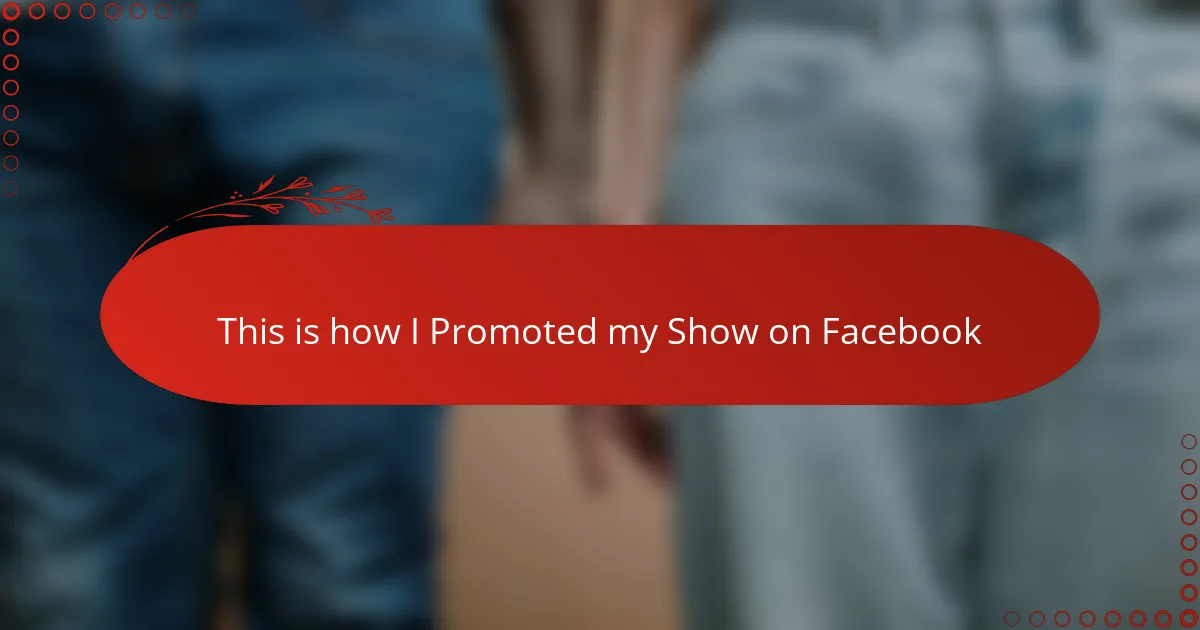Key takeaways
- Effective radio broadcasting relies on quality sound, emotional connection, and engaging content to build a loyal audience.
- Utilizing Facebook promotion tools like targeted ads, events, and boosted posts can significantly enhance audience reach and engagement.
- Setting clear, measurable goals and tracking progress is essential for successful promotion and maintaining momentum.
- Personal engagement and authenticity in content creation foster a stronger community and enhance listener relationships on social media.
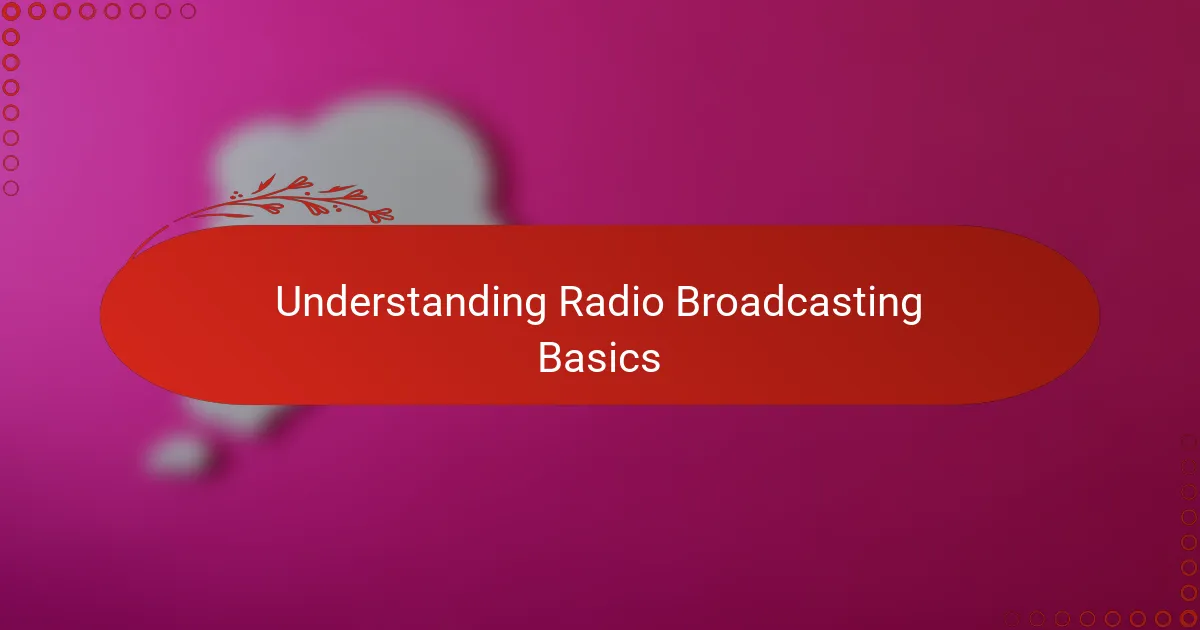
Understanding Radio Broadcasting Basics
Radio broadcasting, at its core, is about connecting with an audience through sound. I remember when I first started, it was fascinating to realize how just a microphone and a transmitter could bring stories, music, and voices into people’s daily lives. Have you ever thought about the magic behind tuning into your favorite show and feeling instantly part of a community?
Understanding the basics means knowing your signal’s reach and the importance of clear audio. When I was learning, I quickly grasped that no matter how great the content, if the broadcast quality isn’t right, listeners won’t stay. It’s like trying to have a meaningful conversation with someone when the phone line keeps cutting out—frustrating and pointless.
There’s also an emotional element in radio that often gets overlooked. Unlike visual media, radio relies on imagination. Have you noticed how a well-crafted intro music or a warm voice can set the mood and create anticipation? That’s where the art of radio lies, making listeners feel something powerful without them even seeing you.
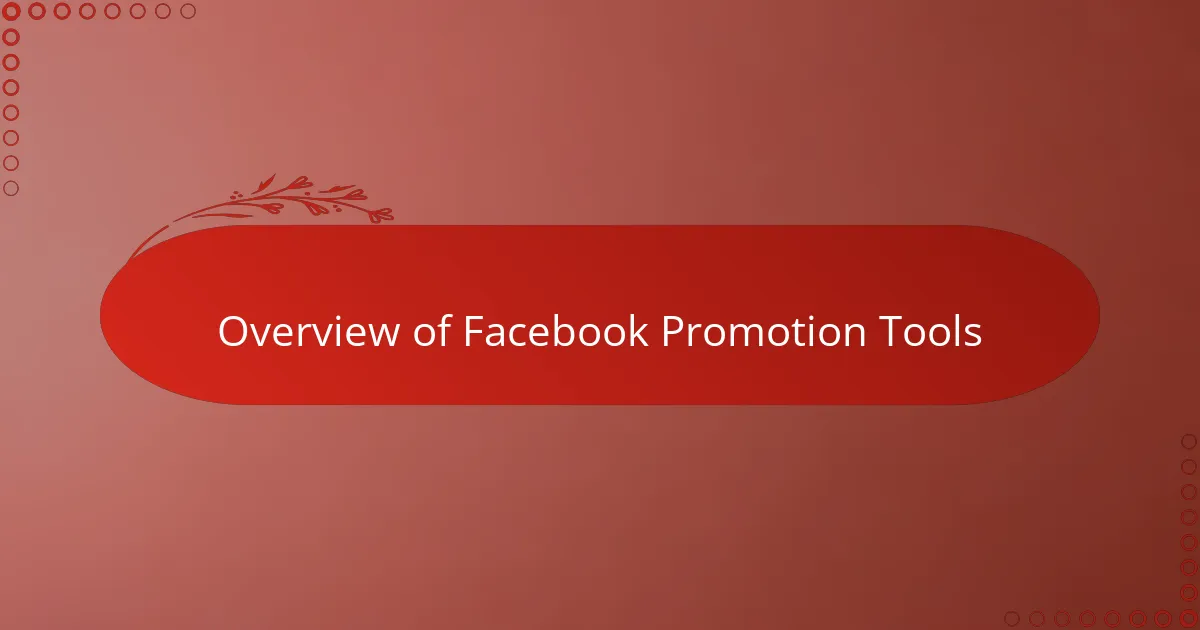
Overview of Facebook Promotion Tools
Facebook offers a variety of promotion tools that have been game-changers for growing my radio show’s audience. Tools like Facebook Ads let you target specific listeners based on interests, location, and behavior, which means every dollar spent feels like a direct conversation with the people who matter most. I remember the first time I tried running an ad campaign—I was amazed by how quickly my show’s page visits spiked.
Beyond ads, Facebook’s Events feature became my go-to for announcing live shows and encouraging listener interaction. It’s incredible how a simple event invite can turn casual fans into engaged participants, almost like inviting friends to your own living room. Have you ever noticed how notifications about events can spark curiosity and build anticipation?
Then there’s the power of boosted posts. I used to think organic reach was enough until I saw how boosting a well-crafted update could instantly breathe life into a post that might have otherwise been overlooked. It’s like giving your message a megaphone, ensuring that your voice echoes louder in the crowded digital airwaves.

Setting Goals for Show Promotion
Setting clear goals was the first step that changed how I approached promoting my show on Facebook. Without defining what success looked like—whether it was increasing listener numbers, boosting engagement, or driving event attendance—I found my efforts scattered and less effective. Have you ever tried promoting something without knowing exactly what you wanted to achieve? I quickly realized how that sense of direction made all the difference.
For me, breaking down goals into specific, measurable outcomes made the process manageable and motivating. Instead of vague hopes like “get more listeners,” I aimed to increase page followers by 20% within a month or have at least 50 people RSVP to a live event. This focus helped me choose the right Facebook tools and track progress without feeling overwhelmed.
I also learned that setting realistic timelines mattered a lot. Ambitious goals are great, but deadlines keep the momentum going. When I scheduled mini-goals leading up to my show’s premiere or special episodes, the excitement built naturally—both for me and for my growing audience. Have you noticed how a clear goal can turn a promotion from a chore into a challenge worth pursuing?

Creating Engaging Content for Facebook
Creating content that truly grabs attention on Facebook was a learning curve for me. I found that posts with authentic stories or behind-the-scenes glimpses of my show sparked real conversations. Have you ever shared something small that unexpectedly drew people in? That’s the kind of genuine connection I aimed for.
I also experimented with mixing formats—short videos, polls, and eye-catching images. It surprised me how a simple question in a post could boost engagement more than a long update. Making content interactive felt like inviting listeners right into the studio, not just watching from afar.
One thing I realized is how important timing and consistency are. Posting regularly at moments when my audience was most active helped keep my show on their minds. It’s like tuning a radio to the perfect frequency—if you miss that moment, the message won’t reach as clearly. Have you noticed how some posts just fade away while others echo?
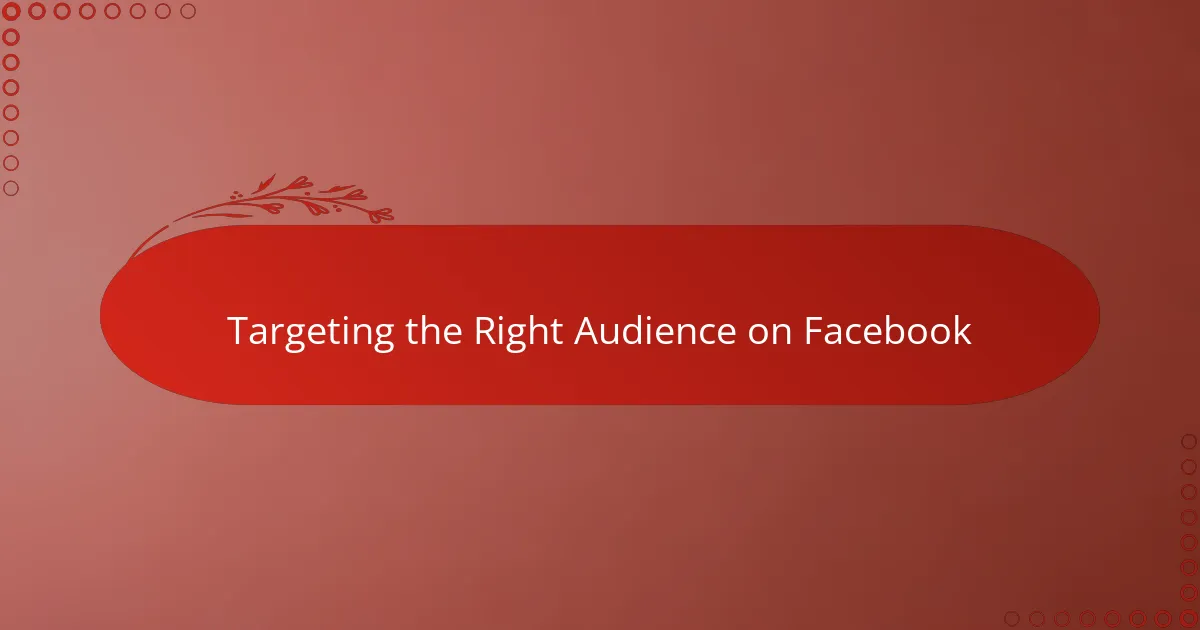
Targeting the Right Audience on Facebook
Finding the right audience on Facebook felt like a puzzle at first, but targeting specific demographics made all the difference. I started by zeroing in on listeners who loved the music genres and topics I covered, which instantly made my promotions feel more personal and relevant. Have you ever noticed how ads tailored just for you catch your eye more than random posts?
Using Facebook’s detailed targeting options, I could focus on listeners by age, location, interests, and even behavior—meaning my show reached people who were genuinely interested. For me, narrowing down the audience wasn’t about excluding others; it was about speaking directly to those most likely to tune in and engage. It felt like finally calling out to friends who were waiting to hear what I had to say.
One surprising insight was realizing that sometimes less is more. Over-targeting risks missing curious ears just outside the usual circles. So, I balanced precision with some broader targeting to keep the audience growing organically. Have you tried adjusting your targets to find that sweet spot where your message resonates best? For me, that experimentation was key to building a loyal listener base on Facebook.
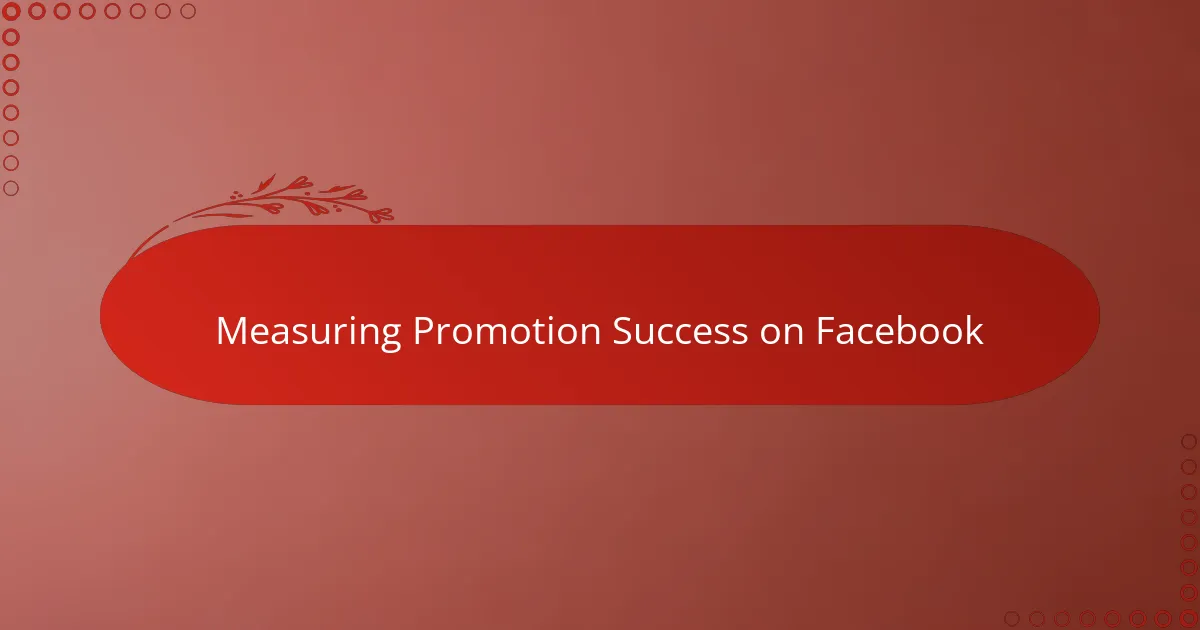
Measuring Promotion Success on Facebook
Measuring how well my Facebook promotion actually worked was a bit like tuning a dial—I needed to find the right markers to tell me if my efforts were hitting the mark. Facebook’s Insights dashboard became my best friend, showing me who was clicking, liking, and sharing my posts in real time. Did you ever feel that thrill when you watch those numbers climb and realize your show is reaching new ears? That feedback loop kept me motivated and informed.
I learned early on that not all metrics carry the same weight. For example, page likes felt good but didn’t always translate into actual listeners dropping by during a live show. Instead, I found that engagement rates—comments, shares, event RSVPs—offered more practical clues about who was genuinely interested. It’s like tuning into listener reactions during a live broadcast; some applause means little unless the audience stays tuned in.
Tracking conversions from ads to actual show attendance or website visits was another revelation. At first, I struggled to connect those dots, but setting up Facebook Pixel helped me follow the trail from a click to a listen. Have you ever found that link between an online ad and your show’s real-world impact? For me, that clarity changed how I spent my budget and where I focused my creative energy.
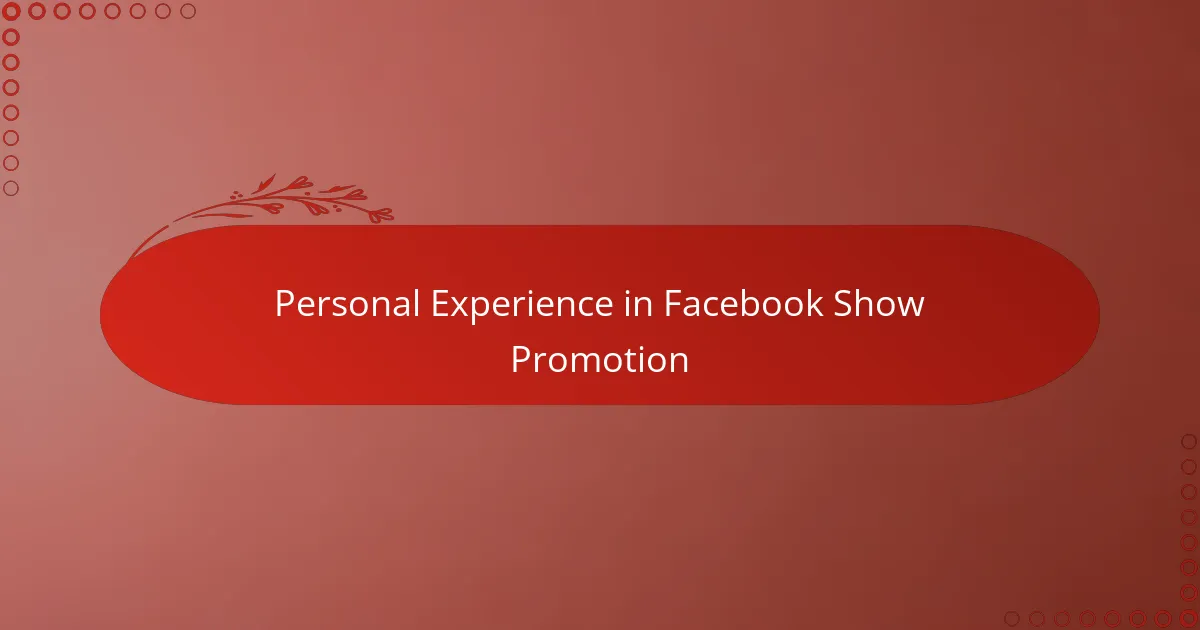
Personal Experience in Facebook Show Promotion
When I first promoted my show on Facebook, I didn’t realize how much patience it would take. I remember posting consistently for weeks before seeing any real engagement. Have you ever felt like you’re shouting into the void? That’s exactly how it felt, but sticking with it taught me the value of persistence.
One moment that stuck with me was when a simple behind-the-scenes photo unexpectedly sparked dozens of comments and shares. It made me realize people crave connection, not just promotion. That small interaction gave me the confidence to share more authentically and foster a community rather than just push content.
I also learned that responding personally to comments made a huge difference. When listeners saw I was genuinely interested in their feedback, the relationship deepened. Have you tried turning casual fans into friends? For me, that personal touch transformed my Facebook page from a bulletin board into a vibrant conversation hub.
